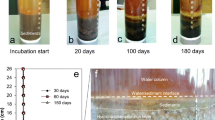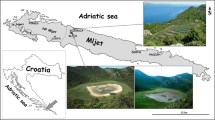Abstract
During summer stratification,Metallogenium personatun was found exclusively in the hypolimnion of Lake Washington where the oxygen tension was below 8 ppm. Numbers of the organism decreased in the lake immediately following turnover in October. Significant concentrations ofMetallogenium microcolonies did not recur until spring, after the lake had stratified. During stratification the distribution of particulate manganese closely followed the distribution ofMetallogenium. EDAX analysis, confirmed by electron microprobe analyses of the encrustation, showed that the primary component was manganese. Iron and some trace elements were also precipitated on the organism but to a lesser degree. In addition, phosphate, the primary substance limiting phytoplankton growth in Lake Washington, was found in the encrustation, indicatingMetallogenium maybe important in limiting algal blooms in the lake. Attempts to growMetallogenium in the laboratory were unsuccessful. This inability, combined with the negative results of thin-sectioning and acridine orange staining ofMetallogenium microcolonies, suggests that the microcolonial structures seen in Lake Washington are not a living form of an organism.
Similar content being viewed by others
References
Bromfield, S. M.: Bacterial oxidation of manganous ions as affected by organic substrate concentration and composition. Soil Biol. Biochem.6, 383–394 (1974)
Crecelius, E. A.: The geochemical cycle of arsenic in Lake Washington and its relationship to other elements. Limnol. Oceanogr.20, 441–451 (1975).
Dondero, N. C.: TheSphaerotilus-Leptothrix group. Annu. Rev. Microbiol.29, 407–428 (1975)
Drabkova, V. G., and E. A. Stravinskaya: Role of bacteria in the dynamics of iron in Lake Krasnoe. Mikrobiologiya38, 364–371 (1969) (in Russian)
Dubinina, G. A.: Inclusion ofMetallogenium among the Mycoplasmatales. Doklady Akademii NaukSSSR. (Doklady Biological Sciences English Translation)184, 87–90 (1969)
Dubinina, G. A.: X. Ecology of freshwater organisms. 1. Aquatic bacteria. The significance of microbiological processes in lakustrine manganese ore formation. Verb. Int. Verein. Limnol.18, 1261–1276 (1973)
Edmondson, W. T.: Nutrients and phytoplankton in Lake Washington. In G. E. Likens (ed.): Nutrients and Europhication. Am. Soc. Limnol. Oceanogr. Spec. Symp. I (1972)
Guseva, K. A.: Two planktonic microorganisms participating in the iron cycle. Trans. Biol. Station Borok.2, 24–31 (1956) (in Russian)
Hobbie, J. E., R. J. Daley, and S. Jasper: Use of nuclepore filters for counting bacteria by fluorescence microscopy. Appl. Environ. Microbiol.33, 1225–1228 (1977)
Hutchinson, G. E.: A Treatise on Limnology, Vol. I. John Wiley and Sons, London (1957)
Jones, J. G.: Studies on freshwater bacteria: effect of medium composition and method on estimates of bacterial population. J. Appl. Bacteriol.33, 679–686 (1970)
Klaveness, D.: Morphology, distribution and significance of the manganese-accumulating microorganismMetallogenium in lakes. Hydrobiologia56, 25–33 (1977)
Kossaya, T. A.: Composition of manganese oxides in cultures ofMetallogenium andLeptothrix. Mikrobiologiya36, 1024–1029 (1967) (in Russian)
Lebedeva, M. N., and G. V. Shumakova: Reliability of data obtained by the method of direct bacterial count on filters. Mikrobiologiya38, 351–357 (1969) (in Russian)
Lund, J. W., C. Kipling, and E. D. LeCren: The inverted microscope method of estimating algal numbers and the statistical basis of estimations by counting. Hydrobiologia11, 143–170 (1958)
Merek, E. L.: Imaging and life detection. BioScience23, 364–371 (1973)
Perfil'ev, B. V., and D. R. Gabe: Capillary Methods of Investigating Microorganisms. University of Toronto Press, Toronto (1961) (English translation, 1967)
Reynolds, E. S.: The use of lead citrate at high pH as an electron-opaque stain in electron microscopy. J. Cell Biol.17, 208–212 (1963)
Shapiro, J., W. T. Edmondson, and D. E. Allison: Changes in the chemical composition of sediments of Lake Washington, 1958–1970. Limnol. Oceanogr.16, 437–452 (1971)
Sokolova, G. A.: Seasonal changes in the species composition and numbers of iron bacteria and iron cycle in Lake Glubokoye. Trudy Vsesojoznovo Gidrobiol. Oblschestva11, 5–11 (1961) (in Russian)
Sokolova-Dubinina, G. A., and Z. P. Deryugina: Process of iron-manganese concretion formation in Lake Punnus-Yarvi. Mikrobiologiya36, 1066–1076 (1967) (in Russian)
Staley, J. T.: Incidence of prosthecate bacteria in a polluted stream. Appl. Microbiol.22, 496–502 (1971)
Taras, M. J., A. E. Greenberg, R. D. Hoak, and M. C. Rand: Standard Methods for the Examination of Waterand Wastewater, 13th Ed. American Public Health Assoc., Washington, D. C. (1971)
Van Veen, W. L.: Factors affecting the oxidation of manganese bySphaerotilus discophorus. Antonie van Leeuwenhoek J. Microbiol. Serol.38, 623–626 (1972)
Walsh, F., and R. Mitchell: An acid-tolerant iron-oxidizingMetallogenium. J. Gen. Microbiol.72, 369–376 (1972)
Zavarzin, G. A.: Symbiotic culture of a new microorganism oxidizing manganese. Mikrobiologiya30, 393–395 (1961) (in Russian)
Zavarzin, G. A.: Structure ofMetallogenium. Mikrobiologiya32, 1020–1023 (1963) (in Russian)
Author information
Authors and Affiliations
Rights and permissions
About this article
Cite this article
Gregory, E., Perry, R.S. & Staley, J.T. Characterization, distribution, and significance ofMetallogenium in Lake Washington. Microb Ecol 6, 125–140 (1980). https://doi.org/10.1007/BF02010551
Issue Date:
DOI: https://doi.org/10.1007/BF02010551




